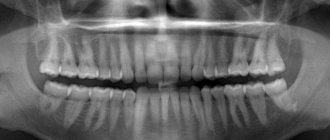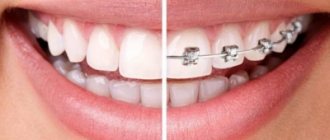Who is a periodontist?
A periodontist is a highly qualified specialist involved in the diagnosis and treatment of periodontal diseases - the soft periodontal tissues that provide teeth with reliable fixation in the jaw.
The periodontist, as a highly specialized doctor, must have in-depth knowledge of the methods of treating various types of soft tissue diseases. In his practice, he uses antibiotics, special dental equipment, resuscitation agents and drugs to treat gums.
What diseases does a periodontist treat?
Periodontal therapy includes the following diseases:
- Periodontitis. Inflammatory processes of soft periodontal tissues of an infectious nature. It is characterized by difficult to bear, painful sensations, especially during chewing food, is accompanied by bleeding and the formation of ulcers, and can contribute to complete tooth loss.
- Periodontal disease. A systemic disease that is non-infectious in nature and destroys the periodontal tissues. Periodontal disease is dangerous because in the first stages it is difficult to recognize it on your own. But some signs will still help to identify the need for examination: reduction of alveolar processes, constant itching in the gums and exposure of the area between the dental crown and root. If periodontal treatment is not started in time, periodontal disease will lead to tooth loss, and the poor condition of the soft tissues will not allow the installation of dentures or implants.
- Gingivitis. Gum disease with obvious signs by which you can easily understand that an inflammatory process has begun. These include: swelling, bleeding, pain in the gums, and unpleasant odor. It is not difficult to get rid of gingivitis; it is important to go to a dental clinic in time and be observed by a specialist and follow his recommendations.
- Tooth root cyst. A tumor appears deep in the gum, near the root of the tooth, has a round shape and is filled with a purulent accumulation. It is difficult to detect a cyst on your own; most often this happens after x-ray examinations during the treatment of other teeth. But it can cause constant aching pain that does not go away even after taking painkillers, periodontal swelling, headaches and increased body temperature.
- Stomatitis. Inflammation of the oral mucosa, accompanied by erosion, the appearance of ulcers, abscesses, blisters and the formation of white plaque. Most often it is infectious in nature, so if these signs are detected, you should immediately consult a doctor.
What diseases does a periodontist treat?
The periodontist primarily deals with the treatment of inflammatory diseases of soft dental tissues.
Diseases of the gums and periodontal tissues can be accompanied by severe pain. Over time, the gums begin to bleed and suppuration forms in the oral cavity. Most often, such symptoms signal periodontitis (an infectious and inflammatory process that damages tooth tissue and gums). The main cause of periodontitis is disruption of the proper functioning of organs. Parts of the teeth begin to become exposed, and the sensitivity of the enamel increases.
The periodontist also treats root cysts of the tooth, which is a benign neoplasm at the base of the root. With this disease, suppuration occurs and an infectious process develops. The pain intensifies over time, the gums become red, inflamed and swollen.
An equally common disease treated by a periodontist is stomatitis. It causes inflammation of the oral mucosa. Stomatitis is usually caused by the presence of viruses, bacteria or fungi in the mouth. With fungal stomatitis, a white coating appears on the surface of the mucous membrane, which is accompanied by unpleasant sensations.
At the first signs of oral diseases and gum inflammation, you should consult a specialist.
When do you need to urgently visit a periodontist?
All of the above signs of pathologies are a good reason to make an appointment with a dentist. In these cases, self-medication is strictly prohibited, since treatment should be aimed at eliminating not the signs, but the causes of the disease. And only a professional specialist can identify them and prescribe effective therapy.
The main signs of the need for examination by a periodontist include:
- bleeding gums;
- the first signals of the onset of the inflammatory process;
- painful sensations in the gums;
- release of fluid when pressing on the gums;
- noticeable loosening of teeth;
- the appearance of periodontal pockets in the periodontal areas;
- peeling of soft tissues and their subsidence;
- exposure of the dental neck;
- putrid taste and bad breath that does not go away even after brushing or rinsing;
- suppuration;
- change in the angle of inclination of the teeth.
All of the above signs indicate dangerous changes that require immediate medical attention.
Periodontist - what does he treat?
The author of the article is a dentist-periodontist, candidate of medical sciences, Tokmakova I.A.
Oral health is of great importance for the proper functioning of the human body as a whole. It is no secret that when certain functions are lost, the normal functioning of all internal organs and systems is disrupted. Therefore, every person should monitor the health of their teeth and oral mucosa, and not only for aesthetic reasons. If any problems arise, a periodontist will come to the rescue. Who is this?... I am sure that this is the first time many people have heard this definition.
Let's take a closer look at who a periodontist is, what his duties include, and when the time comes to contact him.
A periodontist is a highly qualified specialist who is involved in the diagnosis, treatment, and prevention of periodontal diseases. The periodontium is a complex of tissues that surround the tooth and provide its fixation in the jaw bones. The condition of the oral cavity and the patient’s body as a whole depends on the professionalism of such doctors.
You should contact a periodontist if you are concerned about:
- bleeding gums during hygiene procedures, meals, or even without contact with anything hard;
- purulent discharge from under the gingival margin;
- pain in the gum area during chewing;
- swelling and discoloration of the gums;
- bad breath;
- mobility of teeth and changes in their position;
- exposure of the necks of the teeth and increased sensitivity;
- formation of tartar and plaque.
When visiting a periodontist, the patient does not always know what exactly the doctor will do and how to carry out the treatment.
At the initial appointment, the doctor asks about complaints and examines the patient. The doctor is interested in occupational hazards, nutritional patterns, and bad habits. Identifies past and systemic diseases. Conducts an external examination of the maxillofacial area and oral cavity, palpation of the lymph nodes. Determines periodontal status: the presence of periodontal pockets and their depth, tooth mobility. Determines the index of the level of oral hygiene, the amount of supra- and subgingival dental plaque. Dental photography and x-ray examination are carried out, which are mandatory to make a full, detailed diagnosis of a patient with periodontal disease. The periodontist may also prescribe blood tests.
Mandatory measures include consultation with dentists of related specialties in order to determine the quality of previously performed therapeutic, orthopedic and orthodontic treatment, and bite pathology.
Based on the results of the examination, the periodontist makes a detailed diagnosis, on the basis of which a comprehensive treatment plan for the patient will be drawn up. The volume of manipulations and timing of treatment depend on the severity and extent of the disease. The principles of treatment of periodontal diseases are complexity, individuality, consistency, systematicity, as well as balance.
Upon completion of the main course of treatment, the patient must come for periodic examinations once every 3 or 6 months, or according to an individual schedule. To maintain a sustainable treatment result, regular patient visits to a periodontist are a must.
The periodontist is not scary! There is no need to be afraid of it if you want to maintain healthy teeth for life. A dentist - periodontist - is an irreplaceable doctor, he does good deeds.
Healthy teeth and gums are a very important part of our charm. They provide quality of life and self-confidence. They enable us to fully enjoy our meals and speak clearly, and enable us to face everyday and unusual situations with interest and pleasure. Simply put, intact, beautiful teeth and healthy gums are additional self-confidence, an indicator of culture and upbringing.
This is exactly how we want to see our patients!
What stages does an appointment with a periodontist include?
Treatment in the periodontist’s office can be divided into 3 main stages:
- Elementary. This stage includes a visual examination of the oral cavity and the necessary diagnostics. If the pathology is not serious and manifests itself only as mild inflammation, then the doctor can only prescribe anti-inflammatory drugs and special hygiene.
- Surgical. Actually the treatment itself, the methods of which differ and depend on the type of disease. It is necessary to wash the formed pockets in the periodontium with special solutions and remove subgingival deposits, if any. In difficult situations, the periodontist resorts to surgical methods.
- Prophylactic. The specialist talks about prevention methods at home and prescribes a follow-up appointment for maintenance therapy.
Advice from periodontists
In order to preserve the health of your gums, you need to use dental services twice a year and scrupulously follow the rules of hygiene.
Advice from doctors on oral care:
- Hygiene procedures must be carried out daily, morning and evening, without any exceptions. This is the main guarantee of periodontal health.
- During the day, after each meal, rinse your mouth; if you don’t have a special mouthwash on hand, you can use plain water. Any remaining food particles between the teeth must be removed using dental floss.
- The toothbrush should be chosen correctly; it should have a rounded end and medium-hard bristles, which will prevent damage to the gums during brushing.
- The toothbrush should be changed quite often, at least once every 4 months, otherwise it becomes an ideal place for the accumulation of dangerous bacteria.
- The choice of toothpaste should also be taken seriously, since it is its composition that determines how effective the cleansing of all components of the oral cavity will be. There are special pastes containing useful components and additives that will help eliminate problems with soft tissues.
What is an appointment with a periodontist like?
The cause of gum disease can be not only poor oral hygiene, but also old dentures, dental crowns and fillings.
At the appointment, the dentist performs an initial examination to determine the nature and degree of inflammation. After diagnosis, the periodontist develops a course of therapy and gives recommendations on oral hygiene.
If the disease is severe, you may need to visit your periodontist several times. He may prescribe additional diagnostics that will help resolve the problem.
Where can you go in Ivanteevka if you have gum disease?
If you need the help of a periodontist, you can contact the Sanident dental clinic, one of the best in Ivanteyevka, as confirmed by reviews from our satisfied patients. We employ only professionals with extensive experience who use modern treatment methods, the best equipment and reliable drugs. With us you can quickly and inexpensively restore health to your teeth and gums.
Complex dentistry "Sanident" is located at the following addresses:
- Ivanteevka, st. Novoselki, 4 (Ivanteevka railway station);
- Shchelkovo, st. Central, 80 (railway station Voronok).










